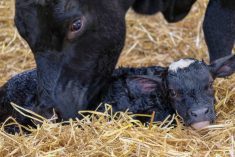Whether dairy producers provide a single or two-stage dry cow feeding program, it is important that it maintains or puts the right amount of body condition to prepare cows for a successful lactation.
A closer review of any of these dry cow feeding programs (with proper management) will find certain similarities. Plus, they should dovetail into most high-energy lactation diets. Failure to do so will bring about all sorts of metabolic problems, particularly in the early-lactation cows. That is why it’s best to choose a well-thought-out feeding and management program that works for your dry cows.
As a dairy nutritionist, I believe in a two-stage dry cow feeding and management program. I recommend that once a dairy cow completes a 305-day lactation cycle, that she is properly dried off and put into a 60-day dry cow program that includes a faraway stage of 40 days followed by a 20/21-day close-up stage.
Read Also

Harvest wraps up and fall work begins
At the Eppich famly ranch in western Saskatchewan, the fall harvest was successful with few breakdowns, cows and calves have been sorted and a new tractor has arrived
I believe that separate faraway dry cow time is necessary. First, it allows a “resting” phase, which permits udder involution (where milk secretory cells lost in lactation regenerate and increase in number). Second, it allows the rumen to rebound and tissue linings and muscle tone to be restored. And finally, the first 40 days heals internal organs such as the liver, which were likely damaged by high grain- and fat-enriched diets and the metabolic demands of high milk production.
I also like to see that late-lactation cows are brought into the faraway dry period in a body condition score of 3.0-3.5. To maintain this optimum BCS as well as support healthy growth of their fetus, a faraway dry cow should consume about 2.0 per cent of her bodyweight (dm basis) of well-balanced feed made up mostly of bulky and good-quality grass-type forages. The whole diet should then supply about 14-16 Mcal of dietary energy (or TDN equal to 60 to 62 per cent), 13 to 14 per cent crude protein, complemented by 0.50 per cent calcium, 0.30 per cent phosphorus, 0.5 per cent salt and trace minerals (copper, zinc, selenium) and vitamins (A = 100,000, D = 3,000 and E = 1,000 iu/head). Lastly, 10 g per head per day of commercial yeast should be included.
Once the 20 to 21 close-up feeding program rolls around, it should be formulated to carry a modest amount of dietary energy, namely, 0.60-0.65 Mcal/lb. (dm, basis) as well as 14 to 15 per cent protein. Also a balance of calcium and phosphorus in a 1.5:1.0-2.5:1.0 with potassium levels controlled to promote good calcium metabolism. It should have good mineral-vitamin micro-premix to supply essential levels of copper, zinc, selenium, Vitamin A and high levels of Vitamin E (2000-3000 iu/head). B vitamins are added to this mix, such as six grams of niacin and 14 grams of choline to help prevent ketosis and fatty liver syndrome.
I also account for a 30 per cent natural decline in dry matter intake from the start of the faraway dry period to calving. So I want the entire close-up diet to be very palatable. This means that most close-up diets might contain moderate-energy forages such as mixed grass hay (limiting alfalfa), which can be easily complemented with a grain-based pellet and often mixed with some ensiled lactation feed containing either barley or corn silage. These pre-partum cows should be consuming 12 kg of this good feed mixture, which helps them calve out at an optimum BCS of 3.0-3.5.
Dairy producers find the two-stage program works. I visit a 325-cow dairy that separates about 70 faraway dry cows and his 20 close-up animals. The faraway cows are fed a modest-energy, forage-based diet as outlined above. And the close-ups are fed similar forages mixed with a couple of pounds of corn silage and a few pounds of a palatable 16 per cent dry cow pellet. As a result, the producer admits to a few cases of sub-clinical ketosis, but he deems them as not a significant problem.
This producer will also be the first to admit that his dry cow feeding and management program is one of the most challenging aspects of his dairy operation. That’s because the dry cows transition from lactation dairy cows, into faraway dry cows, into close-up dry cows and once calved, back into lactating dairy cows. Each group has their own specific nutrient and TLC needs. Meeting all of the dry cow’s nutritional needs goes a long way toward success of his dairy operation.
















